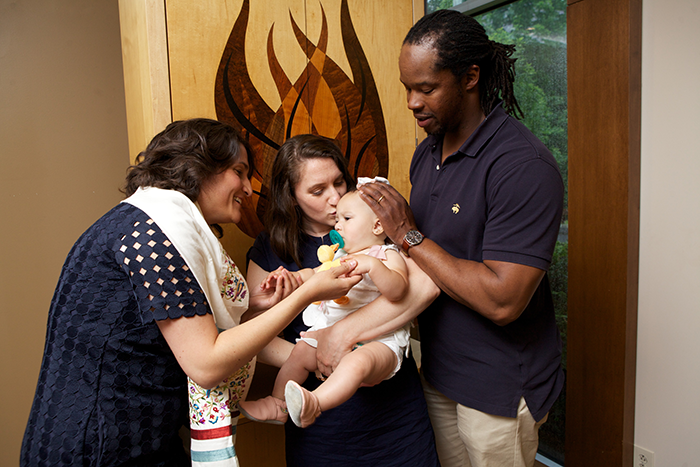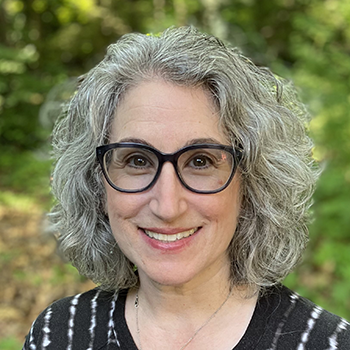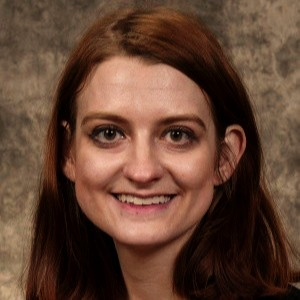
Reform Judaism stands for a Judaism that is inclusive and encourages the participation of all members of interfaith families in our communities. Interfaith families represent a critical segment of the Jewish population in North America. According to the Pew Research Center's report on Jewish Americans in 2020, "nearly half of all non-Orthodox Jews who are married say their spouse is not Jewish (47%)." Affirming interfaith families and ensuring that they have the opportunity to experience a sense of belonging is crucial, since the same study indicates that "intermarriage is more common among those who have married more recently, and among non-Orthodox Jewish respondents who got married since the beginning of 2010, 72% have a non-Jewish spouse."
Sadly, many interfaith couples still report feelings of exclusion and marginalizing experiences in Reform Jewish settings. Here are some steps we can take as community leaders to affirm members of interfaith families, ensure they know they are valued and understood as critical members of our Reform communities, and do our best to ensure that everyone has the opportunity to experience a sense of belonging:
1. Create a DEI Working Group & Utilize the URJ's Audacious Hospitality Community Assessment Tool
Our Community Assessment tool provides congregational leaders with starting points to reflect, discuss, and create an action plan to help your community take steps toward becoming spaces of belonging. The assessment will help you build on your community's existing strengths while working to address areas that may have been overlooked. This assessment is both a process and an idea checklist; it will provide you with a vision of the community that you strive to create and help you identify steps to help all community members feel that they belong. To get the most out of this tool, make sure you complete the entire assessment. Fill out this short form to download the Community Assessment.
2. Examine Your Language Regarding Members of Your Community Who Do Not Identify as Jewish
Our language is imperfect. Recently, the term "Jewish-adjacent" has been used to refer to individuals who do not self-identify as Jewish but are members of a Jewish family, raising Jewish children, or are partnered with a Jew. Some people who might be identified as Jewish-adjacent rally around the term, but others find it objectionable. Whatever term we choose, whether it be "Jewish-adjacent," "interfaith partner," "multi-faith," "non-Jew," "Jewish-and," or something else, may be problematic in its own way. The key is to keep in mind that our communities are most welcoming when we respect the ways people choose to describe themselves by referring to them using the terms they use to describe themselves.
3. Consider the Structure of Your Congregational Governance
Conversations around interfaith inclusion and congregational governance typically concern eligibility for congregational membership (and voting rights), board service, and the synagogue presidency. The general trend has been expanding eligibility for leadership positions. Some congregations even choose to limit the positions of ritual committee chair, president, and similar roles to members who identify as Jews. Other congregations are silent on the topic, while some explicitly state that they have no such restrictions.
If your community does not have Jewish-adjacent participants in leadership positions, make sure that there are ample opportunities for these community members' perspectives to be heard by leadership.
4.Think About How All Community Members Can Participate in Rituals
Conversations around interfaith inclusion and ritual often focus on the honors of reciting the Torah blessings and leading the congregation in prayers that include language like "us" and "our." Decisions around ritual participation are usually determined by rabbis and/or cantors working alongside lay leaders and the ritual committee.
Most, if not all, Reform congregation invites community members who do not self-identify as Jews to participate in worship in various ways but differ as to whether those individuals may lead the congregation in prayer. Some congregations pair members who do not identify as Jews with Jewish family members to recite blessings, others designate certain readings and prayers that these community members can lead, while others place no limits on participation. Consider whether policies outlining your approach will be published in an easily accessible manner or will be discussed in private conversations between clergy and community members who are immediately affected.
Review the URJ's Inclusive Program Checklist, and consider the many ways you could make your programs accessible to people of all backgrounds. This checklist includes best program practices to affirm people who may not have been raised Jewish or were raised Jewish but with little formal Jewish education.
While all of these are great starting points, remember to center the voices of the community members who will be most affected by these decisions. Creating communities of belonging is a process that is at times difficult, always evolving, and will never be fully complete. That said, examining the ways you approach community members who do not identify as Jewish and listening to their needs and experiences will go a long way toward making your community a space of belonging.
Want to learn more? Read some articles that explore the experiences of interfaith families on ReformJudaism.org.
Related Posts

Honoring Transgender and Nonbinary Community Members’ Infinite Value

Making Our Communities Truly Accessible: Beyond Good Intentions



